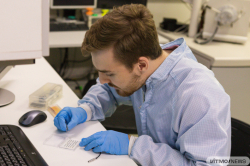Fluorescent microscopy provides an enlarged image of an object due to the luminescence of excited atoms and molecules in the sample. Despite low resolution, fluorescent microscopy is capable of visualising the internal structure of living cells and small organisms. Therefore, this method is currently in demand in biology and medicine. However, non-uniformity of the refraction index of the sample results in a distorted or aberrated image. Scientists and engineers are constantly looking for ways to compensate for aberrations and improve image quality.
For this purpose adaptive optical elements can be used. They can automatically correct the optical aberration for each sample. In fluorescence microscopy, where the amount of light is low, wavefront sensorless methods are preferable. In these methods the aberration is estimated by the adaptive element through computing some image quality metric.
“Previously, we described a metric that provides the fastest and most reliable wavefront estimation. It is based on second-moment luminescence and suits fluorescent microscopy well. Using it we can minimize the total number of measurements so as to avoid photo-bleaching,” says Oleg Soloviev, professor at Delft University of Technology and ITMO University.
These findings became a basis for the new method of computer evaluation of image quality. The main problem of this method was that each sample required a new calibration. The scientists tried to simplify it and created the microscope whose image quality assessment depends on the form of individual points. The sample itself does not influence optic adjustments, so that microscope can adapt to any object.
According to the scientists, the idea of this study appeared within a previous work in the field of fluorescent microscopy.
"After theoretical calculations and modelling we tested our method in action, using two microscopes. The first was initially created on the principle of adaptive optics. The second was an ordinary microscope for student practice. We compared the quality of the images obtained on both microscopes and saw that our method was successful. Finally, we conducted a statistical analysis and validation of the method in comparison with the previously obtained data," notes Paolo Pozzi, PhD, researcher at Delft University of Technology.
Currently, the scientists are trying to advance the developed method so that various defects in the image of any sample would be corrected individually.
"We made the system that improves image overall quality. However, the problem is that we applied the same correction everywhere in the field of view. Now we are working on a technology that will help to adjust defects in individual regions of the image and therefore reach higher resolution," adds Pozzi.
Reference: “Optimal model-based sensorless adaptive optics for epifluorescence microscopy” Paolo Pozzi , Oleg Soloviev, Dean Wilding, Gleb Vdovin, Michel Verhaegen. PLoS ONE. 20 March 2018




